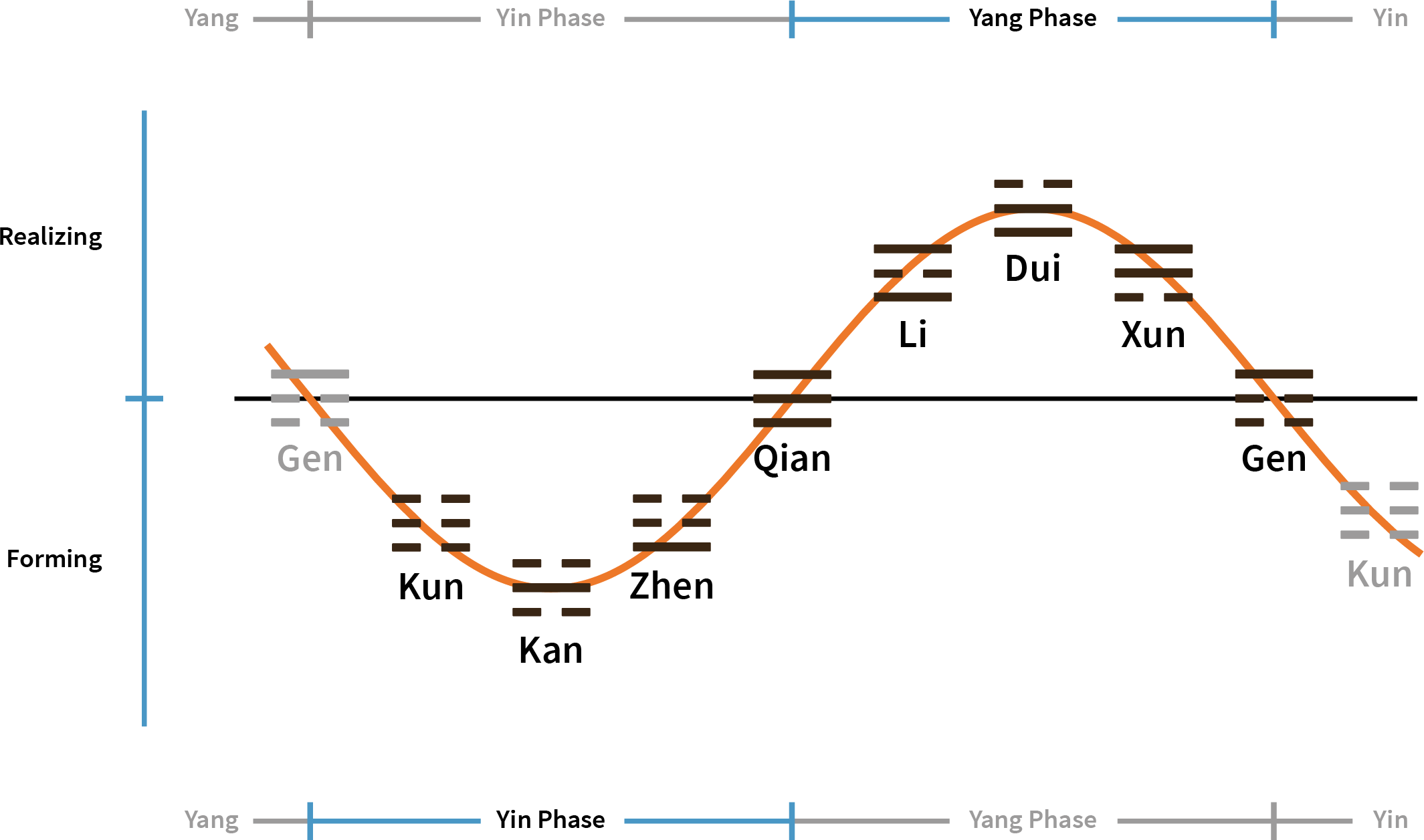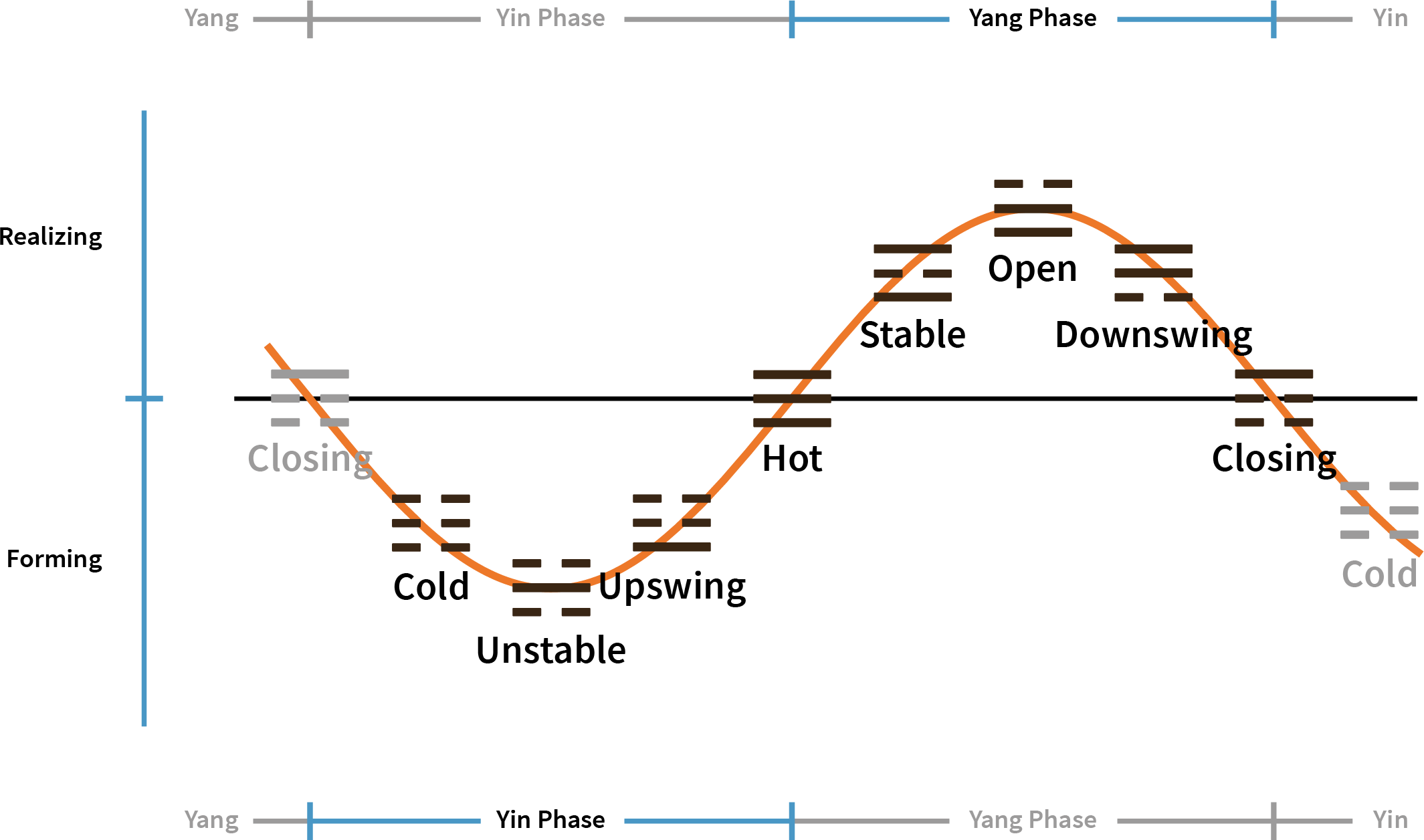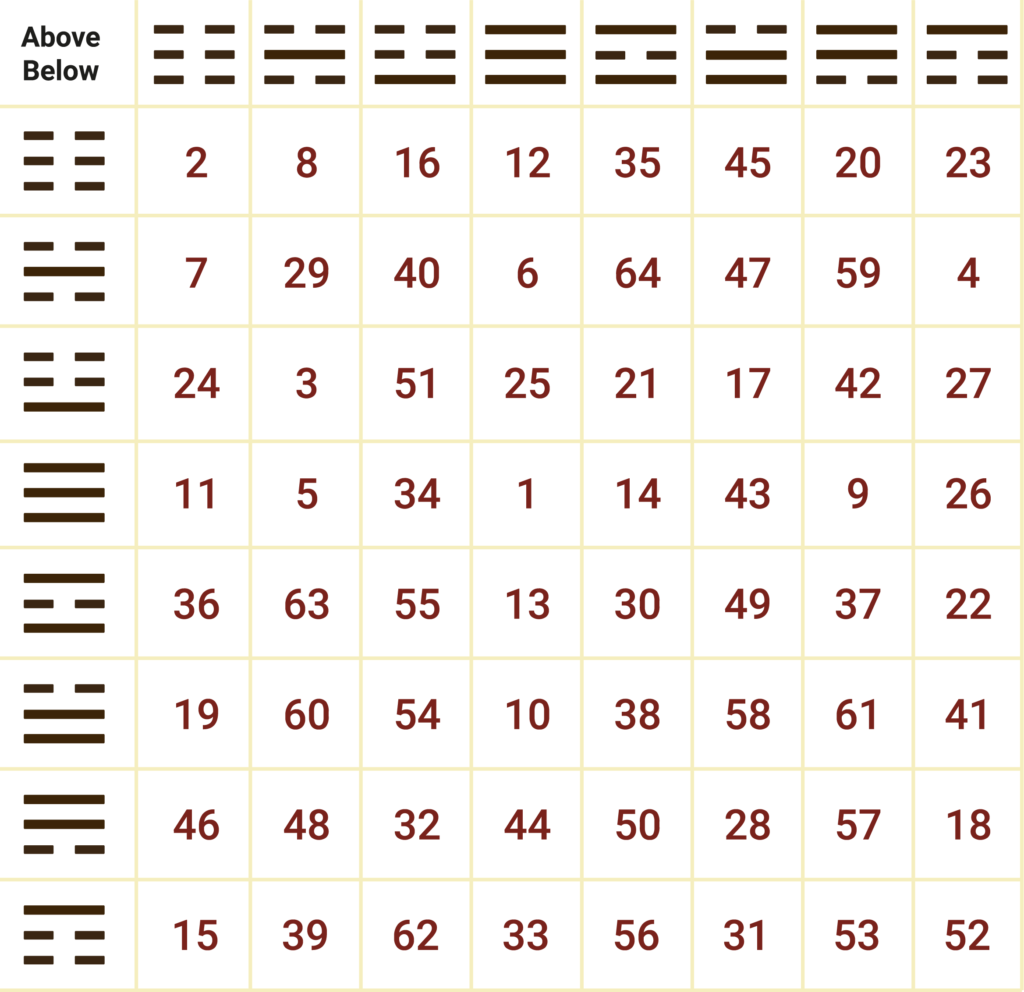I Ching and the Western Systems Theory
How does Yi Jing relate to systems theory?
The arrangement of the basic elements in I Ching
In the tradition of I Ching there are very different arrangements of the hexagrams, trigrams and lines. They are derived from the origin and logic of the lines, they use the authors of the work as a guide, integrate elements of the cosmic order or depict relationships between the trigrams and hexagrams. These classical arrangements base themselves largely on a rather static, structure-oriented view.
When we are using the Western theory of complex systems as a starting point, we arrange the trigrams in a new line of development and call this the Western arrangement. It opens up a completely new view on the I Ching, because it shows the complete life cycle of a question situation or question object:

The new cycle of trigrams not only reflects the dynamics of the trigrams, but also the seasonal cycle of a year and the interplay of Yin and Yang. The new arrangement differs radically from the traditional representations.
Trigrams are systems
The 8 trigrams of I Ching can be viewed as systems in the sense of Western theory of complex or dynamic systems. The I Ching in the Chinese tradition and the systems-oriented thinking of the West are like two sides of the same coin. Indeed, Western descriptions of the dynamics of complex systems come surprisingly close to the images evoked by the I Ching in Chinese culture.
Modern Western ways of thinking in systems and cycles thus leads to new insights into the nature of I Ching and enables further interpretation of consultations. The ancient richness of I Ching’s commentaries on changes in dynamic systems is thereby revealed.
In this model, the 8 trigrams (Ba Gua) represent 8 distinctive system types or system states whose opposing forces come in pairs:
- a warm/hot versus a cool/cold system.
- an upswinging versus a downswinging system.
- a stable versus an unstable system.
- an open as opposed to a closing system.


© Yi Jing LLC
What is the theory of complex or dynamic systems about?
Systems- and interrelationships-oriented thinking and the resulting systems theory emerged – in a nutshell – as an answer to the upheavals of the first half of the 20th century. People began to think about the many interdependencies in nature, in our society and in our values. Atomic physics and especially quantum theory began to dissolve the deterministic outlines of the Western mechanistic world view even outside of expert groups.
In the 1950s and 1960s, researchers in the West realized that many interactions were much more complex than anticipated. They were increasingly confronted with the fundamental unpredictability of developments and events in large, and above all, dynamic systems. The simulation of weather forecasts on computers showed that the slightest changes in an assumption or mere rounding differences in calculations could lead to very diverse results. From this experience, the theory of complex systems came into being. Today it plays an important role in the simulation of dynamic processes. Its ideas have influenced climate research, sociology, psychology, marketing techniques, and many other areas.
What are complex systems?
The modelling of complex and dynamic relations is closely linked to the development of powerful computers. The introduction of computers into this field has added to the variety of descriptions of conversion states and their conditions. Non-linear processes, pattern recognition, climate change, the famous flapping of the butterfly’s wings in Brazil that causes a tornado in Texas, became hot topics. Today, computers monitor the chaotic movements at a pop concert to determine where panic outbursts can arise. Even in the production of organic food, computers calculate the correct amounts of water and feed based on data and patterns supplied by sensors in the ground and in the barn.
Chaos theory became popular and lost itself in endless fractal representations. We are all familiar with the fascinating representations of Mandelbrot sets that dissolve into ever finer structures. The simulation of non-linear processes based on stochastic equations is employed in the calculations of risk scenarios. Suddenly we see how 10’000 times repeated calculations open up a panoply of possible future developments out of a simple starting point. Even these sophisticated simulations are unable to predict the famous “Black Swan” events.
Simultaneously, the Unified Field Theory was pursued in atomic physics, in hopes of finding an all-encompassing theory of the forces in the universe. Superstring theory was an attempt to penetrate subnuclear space. Many calculations and experiments at nuclear research institutions roughly confirm the assumptions of our standard physical model and the theory of relativity.
The theory of complex systems has specialized over the years. It has become broad and confusing, but in its individual applications, it achieves amazingly accurate results.
Examples of complex systems are: man himself, his central nervous system, the climate, the abundance of ideas in young start-ups, religions, financial markets, the Internet, etc. We are surrounded by such systems. They are characterized by the fact that they cannot be simplified in order to understand their dynamics. They behave extremely dynamically and, on occasion, erratically. The climate is deteriorating, a peaceful citizens’ movement is degenerating into street battles; electronic currencies or bull markets are forming asset bubbles and disintegrating.
Complex systems have a number of properties that are not found in simpler systems. These include a degree of self-organization that follows certain patterns. However, these patterns do not follow a simple, linear logic. They behave non-linearly. Even an anthill with millions of ants develops similar structures repeatedly. They are influenced by recurring patterns and states of a system, i.e. the attractors.
Interrelations within and between systems can lead to quite different, seemingly random developments. One speaks of the butterfly effect. A person’s joy and cheering, a revolution or an earthquake in California can create behavioural patterns that seem to be independent of the underlying elements. Such phenomena are referred to as emergence. The emergence of life is one such phenomenon.
All the various interactions in a complex system can generally only take place if the system is constantly supplied with information and energy. If these are not present, it disintegrates. In contrast to complicated systems, complex systems are not inherently stable. They are subject to constant change. One speaks of flow equilibrium and metastability.
Change in complicated systems is predetermined. Planets, for example, follow their predictable orbit deterministically. However, in complex systems, it can also be chaotic, i.e. non-linear (stochastic systems). However, one might find some predictable patterns even within chaos.
The system follows a path when it changes into a new state. If it finds no balance in the new state, it is quite possible that it will return to the old organizational or energy state via the same path. The dynamics of a complex system do not follow fixed rules but are rather influenced by certain probabilities. We can observe this again and again when companies grow in good times and shrink in times of crisis.
Which systems correspond to the trigrams in I Ching?
This new Western arrangement of the trigrams begins with the trigram Kun. It stands for a cool or cold system. Activity in nature, however, is closely associated with heat. The higher the temperature, the faster the molecules of solid matter or gas oscillate. If the molecules move at a high speed, changes occur much more quickly. The paint on the canvas dries quickly, the yeast of the cake in the oven makes it rise. Hot air expands and causes the hot air balloon to rise up. If the energy level or the temperature of a system is low, it changes its state only slowly or is completely at rest. The seeds in winter wait for spring, food in the freezer stays edible because germs cannot degrade it.
In addition, complex systems are always about ‘living’, changing systems. They are in a flow equilibrium. They are metastable, meaning that they return to a natural balance autonomously, in order to adapt to their environment.
So a cool system contains within itself all the information for future growth. As soon as it receives the necessary impulse, such as the warmth of spring, an encouraging speech, or a decisive idea, growth can set in.
The transition to growth is a particularly vulnerable phase. The internal reserves are still low, and foreign influences are much stronger. The seed begins to sprout in spring. If frost returns, if it rains too much or too little, the new life will end prematurely. This is symbolized by the Kan trigram, which stands for water and danger. In systems theory we speak of an unstable system. Its flow equilibrium is not resistant and it can be thrown off course at any time.
If the shoot survives the hazards of the initial phase, growth will gain in strength and momentum. The system swings upward. Temperatures rise and the reactions accelerate. This is described in the Zhen trigram, which stands for an upswinging system. Examples of such growth include the sprouting of leaves and flowers in spring, or energizing enthusiasm for a new technology. We all know this state and are happy about it. The incipient movement can become so strong that it frightens or even overwhelms us.
The exuberant course of growth leads us to the trigram Qian, which stands for a hot system. It is characterized by strong to exuberant energy. We can feel people bursting with energy, young people forming groups, infatuation, and rage. A hot system radiates energy. It is expansive and wants everything, right now.
In the next trigram Li, the structures of the expansive phase solidify. We are talking about a stable system. Growth is losing momentum. The young shoots on the tree lignify, become resistant, and lose part of their flexibility. Something similar happens when social movements organize themselves. They give themselves rules and constitutions and thus maintain their duration, but are no longer as inspiring as in their wild times.
Nature has thus achieved its goal to a certain extent. Another generation of trees, cats, whales and humans has grown up. Satisfaction and openness prevail. This is what the trigram Dui stands for, which corresponds to an open system that is stabilized by its internal values. It can express its needs and maintain flow equilibrium through intense communication. Its arguments are convincing without having to be indoctrinated and universally accepted. That creates room for serenity and celebration.
All complex systems have a life cycle. With Dui gone, the climax has passed. At some point the energy decreases again. Without upswings and downswings, nature would be thrown out of joint. Overgrowth is synonymous with plagues. If the system cannot restore its balance, it will be destructive. The trigram Xun, the sign for a downswinging system, therefore contains a lot of necessity and wisdom. It is about aging, planning for an orderly retreat, and bringing one’s undertakings to a conclusion.
If this succeeds, which is not a given, peace will come. It’s about regeneration and preparing for the next generation of cycles that are always repeating themselves. This is expressed in the trigram Gen, which is a closing system. It reduces its field of action and thus opening up the next cycle.
The Cycle of Trigrams
The alignment of I Ching and systems theory results in a new arrangement of the trigrams. It represents the life cycle of a situation from the beginning to the end. In the formation phase of a development (lower, inner trigram) we find the following trigrams: Kun / cool System – Kan / unstable System – Zhen / upswinging System. These trigrams have an effect in the realization phase (upper, outer trigram): Qian / hot system – Li / stable system – Dui / open system – Sun / oscillating system. With Gen / Closing System, the Yang cycle closes and the next Yin cycle begins.
Forming (Yin phase): New ideas and projects develop out of standstill and calm. This leads to instabilities. Step by step, the ideas take shape and are transformed into actions. The yin lines predominate in the forming cycle.
The Yin-oriented formation of a situation occur primarily within the core of the system, namely the person. Only a little is still visible to the outside. Four of eight trigrams belong to the Yin phase, thus we can assume that about one half of the development of a situation takes place inside a person or an organism.
Realization (Yang phase): The images that have formed inside now become visible and are realized until the cycle closes. The events are mainly influenced by Yang lines.
The realization phase manifests itself accordingly as movement, activity, action, but also aggression and upheaval. The Yang phase also includes four trigrams. This suggests that the other half of a development becomes visible at this point and can be understood as such.

Cycle of the seasons: This Yin-Yang cycle corresponds to the natural seasons: A cold system corresponds to the high winter, an unstable system to the early spring. An upswinging system is symbolized by spring, a hot system by early summer, and a stable system by the ripeness of summer. With the open system we enter early autumn. It is followed by autumn, which is characterized by a decaying system, and then by early winter, when the natural systems come to a close.
Infinite interplay of Yin and Yang - directed progress
The mindset behind the respective trigram or system arrangement is exciting. While the seasons are known to all inhabitants of temperate latitudes from daily experience, the explanatory models for the dynamics of change differ fundamentally. While the Chinese thinking has always been based on the infinite interplay between Yin and Yang, Western ideas have more to do with directed progress and dialectical movements. In our understanding of dynamics, the Christian plan of salvation concentrates on the insights of idealistic-materialistic philosophy.
The highly differentiated perception and description of reality in Chinese culture and its change in the hexagrams explain the dual nature of I Ching, which has always been regarded as both an oracle and a book of wisdom. It also explains why Eastern strategic thinking is generally superior to the Western thinking, which is often more plan-oriented. The act of consulting the I Ching is primarily about understanding the forces influencing the object of the question. The description of their nature, their direction of movement and their strength is the supposedly mysterious oracle.
In the first Copernican Revolution, people in the West had to acknowledge that they were not at the centre of the cosmos. Once again, we are going through such a turning point. The Western man learns that he alone is not the high point of creation, that our achieved positions are quickly lost, and that there is no longer any certainty. This leads to massive fears of loss in the old, male, industrialized societies. Turning to thinking techniques like the I Ching can offer many insights in such a situation: the only thing that remains is the understanding of change.
Special Dynamics of Hexagrams and General Dynamics of Trigrams
The Western arrangement with its dynamic view also leads to a new arrangement of the hexagrams:

© Yi Jing LLC
We follow the sequence in the development cycle of the trigrams for both the vertical and horizontal assignment of the trigrams to the hexagrams. Richard Wilhelm has taken a similar view in his consideration of the houses in the I Ching, but in keeping with tradition he assumes a rather static view. It should be fascinating to think about dynamic lines of development in the overall system of hexagrams in the future.
Not only the trigrams as such, but every single line in the hexagram, its quality, its position, its correspondences and its relations are of great importance. This leads to very different dynamics of the 64 hexagrams. It is mainly explained in the commentaries on the 4096 possible combinations of changing lines in I Ching which offer many insights into how dynamic systems are likely to behave. This is described in detail in the commentary on the dynamics of hexagrams in the I Ching library.
These rules become especially apparent in the 8 hexagrams where the lower and upper trigrams are identical. Here we can follow all phases of the respective system development from the beginning in the subconscious to the formation and realization up to the end of the cycle.
The dynamics of the two trigrams of a hexagram thus mix with the overall dynamics of the hexagram. The same trigram in different hexagrams can have different qualities.
In the background, however, we see a generally valid dynamic of each trigram or system over its life cycle. It appears – sometimes hidden – wherever a trigram or its transformation lines appear and can therefore be used as a supplement to the interpretation of signs and transformation lines. It is explained in the commentary on the dynamics of the trigrams.
How does systems theory help in the interpretation of I Ching’s answers?
The practical usefulness of systems theory lies in the fact that it adds a systematic perspective on many inner connections of a question to I Ching. All the elements of this theory described above can be applied to the interpretation, especially the simulation of the qualities of the individual trigram and its position in the life cycle of the question. This leads to the following questions, for example:
Where does the object in question stand in its life cycle? A single glance at the trigrams in the hexagram suffices to give a first impression of where they stand in their life cycle and what qualities they have. Is it about energy that is oscillating or dwindling? Are the trigrams in the yin or yang phase? Are the trigrams directed towards action or is it more about reflection? Is the situation stable or unstable?
What about the formation of ideas in the Yin phase? The development of your fantasies and ideas into plans and actions is shown above all in the inner/lower trigram. What is the resulting direction of this process? Is it influenced by Yin or Yang signs? Where is its potential for change?
What about the realization of the planned actions? Here, we address the realization phase. It is particularly evident in the outer/upper trigram. Does the realization of your ideas retain its momentum, or does the energy already decrease during the realization? Are you facing a stable situation, or do you have to be careful?
Where are the trigrams in the yin/yang cycle? Under the title ‘Dynamics’, the I Ching library shows the position of the trigrams on the wavy line of the Yin-Yang development. Depending on the hexagram, they move back and forth on the sine curve. We see whether they move in their proper phase or not. What influence do Yin signs have in the Yang phase? How do Yang signs behave in the Yin phase?
What is the relationship between the trigrams in the hexagram? The qualities of the trigrams can complement each other or create tension. They can move towards each other or diverge. This is particularly interesting where they occur in opposite pairs such as hot and cold, stable and unstable.
The commentaries on the hexagrams and trigrams in this section of the app offer further suggestions.
I Ching and systems theory - a bridge between East and West?
In this old and profound text and its accompanying commentaries, the so-called “Ten Wings”, one finds an unbelievably wide variety of attempts to explain the change of systems. We can assume that the Book of Change is the first comprehensive and systematic work on the theory of complex systems.
Through close observation of change in nature and in man, the best thinkers of ancient times have tried to capture changes in the entire cosmos in generalizing and difficult images. Their insights can complement and enrich the Western view of dynamic systems. Conversely, the findings of Western sciences open up new approaches to understanding I Ching and interpreting its answers.
The full text of the commentary on the dynamics of hexagrams and trigrams can be downloaded in the premium version of the I Ching Library.
© Yi Jing LLC

